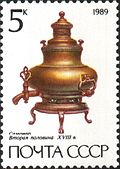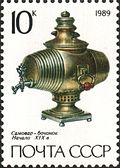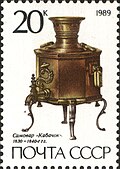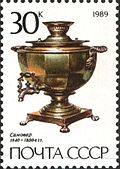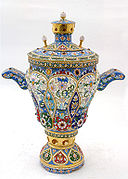Samovar
This article needs additional citations for verification. (December 2010) |

A samovar (Russian: самовар, IPA: [səmɐˈvar] ; literally "self-boiler", Persian: Samāwar, Turkish: semaver) is a heated metal container traditionally used to heat and boil water in and around Russia, as well as in other Central, South-Eastern, Eastern European countries, Kashmir and in the Middle-East. Since the heated water is typically used to make tea, many samovars have a ring-shaped attachment (Russian: конфорка) around the chimney to hold and heat a teapot filled with tea concentrate.[1]
Though traditionally heated with coal or charcoal, many newer samovars use electricity to heat water in a manner similar to an electric water boiler. Antique samovars are often displayed for their beautiful workmanship.
Description
Samovars are typically crafted out of plain iron, copper, polished brass, bronze, silver, gold, tin, or nickel. A typical samovar consists of a body, base and chimney, cover and steam vent, handles, faucet and key, crown and ring, chimney extension and cap, drip-bowl, and teapot. The body shape can be an urn, krater, barrel, cylinder, or sphere. Sizes and designs vary, from large, "40-pail" ones holding 400 litres (110 US gal) to those of a modest 1 litre (0.26 US gal) size.

A traditional samovar consists of a large metal container with a faucet near the bottom and a metal pipe running vertically through the middle. The pipe is filled with solid fuel which is ignited to heat the water in the surrounding container. A small (6 to 8 inches) smoke-stack is put on the top to ensure draft. After the water boils and the fire is extinguished, the smoke-stack can be removed and a teapot placed on top to be heated by the rising hot air. The teapot is used to brew a strong concentrate of tea known as заварка (zavarka). The tea is served by diluting this concentrate with кипяток (kipyatok) (boiled water) from the main container, usually at a water:tea ratio of 10:1, although tastes vary.
The samovar was an important attribute of a Russian household and particularly well-suited to tea-drinking in a communal setting over a protracted time period. The Russian expression "to have a sit by the samovar" means to have a leisurely talk while drinking tea from a samovar. This compares with the German Kaffeeklatsch, Swedish fika or Turkish nargile culture.
In everyday use samovars were an economical permanent source of hot water in older times. Various slow-burning items could be used for fuel, such as charcoal or dry pinecones. When not in use, the fire in the samovar pipe faintly smouldered. As needed it could be quickly rekindled with the help of bellows. Although a Russian jackboot сапог (sapog) could be used for this purpose, bellows were manufactured specifically for use on samovars.
In modern times, the samovar is mostly associated with Russian exotica and nostalgia,[citation needed] though they are also quite popular with Iranian immigrants and their descendants. Samovars may be purchased in Europe, and in the United States, they may be found in neighborhoods with heavily Slavic populations, such as New York's East Village or Coney Island in Brooklyn, or in areas with large Iranian populations like Los Angeles.
- Samovars (from a 1989 series of USSR postage stamps)
-
Baroque samovar, 18th century
-
Barrel type samovar, early 1800s
-
"Squash" type samovar, c. 1830
-
Samovar in the form of a classical vase, c. 1840
History
This section needs expansion. You can help by adding to it. (August 2009) |
In 1989 an archeological dig near Dashust village, Shaki district, Azerbaijan, unearthed a pottery samovar-like utensil identified by a characteristic central tube covered with soot, suggesting it was heated from the inside. It did not however look like modern samovars. In particular, the tube was open at the bottom, suggesting that it was placed over a fire like an ordinary pot. The age of the utensil was indirectly estimated at about 3,600 years.[2] Similar devices have been found in China.[3]
An owner of a unique collection of samovars, Shakhid Gabibullaev, has a modern-type samovar manufactured in 1717, the first known samovar.[citation needed]
The first historically recorded samovar-makers in Russia were the Lisitsyn brothers, Ivan Fyodorovich and Nazar Fyodorovich. From their childhood they were engaged in metalworking at the brass factory of their father, Fyodor Ivanovich Lisitsyn. In 1778 they made a samovar, and the same year Nazar Lisitsyn registered the first samovar-making factory in Russia. They may not have been the inventors of the samovar, but they were the first documented samovar-makers, and their various and beautiful samovar designs became very influential throughout the later history of samovar-making.[4] These and other early producers lived in Tula, a city known for its metalworkers and arms-makers. Since the 18th century Tula has been also the main center of Russian samovar production, with tul'sky samovar being the brand mark of the city. A Russian saying equivalent to "carrying coal to Newcastle" is "to travel to Tula with one's own samovar". By the 19th century samovars were already a common feature of Russian tea culture. They were produced in large numbers and exported to Central Asia and other regions.
-
Russian silver & enamel samovar, late 19th century
-
Russian silver & enamel samovar with cup & tray, late 19th century
Samovars in Iran

Samovar culture has an analog in Iran and is maintained by expatriates around the world. In Iran, samovars have been used for at least two centuries and electrical, oil-burning or natural gas-consuming samovars are still common. Samovar is pronounced samāvar in Persian (Samāwar). Iranian craftsmen used Persian art motifs in their samovar production. The Iranian city of Borujerd has been the main centre of samovar production and a few workshops still produce hand-made samovars. Borujerd’s samovars are often made with German silver, in keeping with the famous Varsho-Sazi artistic style. The art samovars of Borujerd are often displayed in Iranian and Western museums as illustrations of Iranian art and handicraft.
Samovars in Kashmir
A samovar is a traditional Kashmiri kettle used to brew, boil and serve tea and kahwa. Kashmiri samovars are made of copperware with engraved or embossed calligraphic motifs.[5] Inside a samovar there is a fire-container in which charcoal and live coals are placed. Around the fire-container there is a space for water to boil. Tea leaves, sugar, cardamom, and cinnamon are put into the water.[6]
Turkish Samovars
References
- ^ ЭЛЕКТРОСАМОВАР ЭСТ 3,0/1,0 - 220, Руководство по эксплуатации, Государственное унитарное предприятие "Машиностроительный завод "Штамп" им. Б.Л. ВанниковаЭ, 300004, г. Тула
- ^ Akhundov, Tufan (Autumn 2000), "Birth of the Samovar?", Azerbaijan International, pp. 42–44
- ^ Российский гуманитарный энциклопедический словарь: В 3 т. — М.: Гуманит. изд. центр ВЛАДОС: Филол. фак. С.-Петерб. гос. ун-та, 2002
- ^ "Самовары Лисицыных (Lisitsyns Samovars)", Sloboda (in Russian), RU
- ^ "Original Kashmiri Samovar". Kashmir.net. 8 June 2012.
- ^ "Kashmiri Samaovar". kousa.org. 8 June 2012.
- How To Brew The Perfect Tea, CA: Megaforce.
- Israfil, Nabi (1990), Samovars: The Art of the Russian Metal Workers, Fil Caravan, ISBN 0-9629138-0-4.

